
The pandemic has brought a huge amount of attention to indoor air quality, even without full acceptance of the aerosol transmission of COVID-19. Unfortunately, it has also brought a huge amount of money to companies selling questionable electronic “air cleaners.” And that in turn has brought a huge amount of pushback from the IAQ research community.
Recently, I spoke with Dr. Marwa Zaatari, a mechanical engineer and IAQ consultant who is on ASHRAE’s Epidemic Task Force, and she gave me the lowdown on electronic air cleaners. She’s been immersed in this field for about six years and has been one of the most vocal opponents of electronic air cleaners, especially those that use ionization. Before we get into her take on the subject, though, let’s define what we’re talking about here.
Indoor air pollutant types
We can divide the bad stuff in your indoor air into two categories: particles and gases. Particles come in a wide range of sizes and come from different sources. Larger particles are 100 microns or so in size. They include the things you can see floating around in the air when the lighting conditions are right, as well as things that are not quite visible to the naked eye. A lot of these settle out of the air because of their weight.
Once we get down to 10 microns and less, the particles not only float in the air longer but also can penetrate deeper into your body. Larger particles don’t make it past the upper respiratory system. Smaller particles, especially those that are 2.5 microns and smaller (PM2.5), can make it deep into your lungs and from there into the blood stream. These particles are one of the worst indoor air pollutants. Some of them also carry viruses and bacteria that spread disease.
Gases are individual atoms or molecules that are on the order of 0.0001 microns. There are a whole lot of gases that can be pollutants in your indoor air. Some of the most common ones found indoors are nitrogen dioxide, ozone, carbon monoxide, and radon, although there are many other potential indoor air pollutants in the gaseous form.
The world of air cleaners
As with pollutants, we can divide air cleaners into two categories: mechanical and electronic. Mechanical air cleaners may use electricity to move the air, but the cleaning action is purely mechanical. Basically, it’s filtration. Air moves through a filter and pollutants traveling along with the air are captured through one of several mechanical processes (straining, inertial impaction, etc.). The better the filter, the more pollutants are captured. Filters are great at capturing particles but standard filters let the smaller gases pass through freely. To filter out gases, you need activated carbon or chemisorbent filters.
Electronic air cleaners operate on a variety of principles and come with an even greater variety of names. The main ones are:
- Ultraviolet germicidal irradiation (UVGI)
- Electrostatic precipitators
- Ionization
- Photocatalytic Oxidation (PCO)
- Ozone generators
I wrote about ultraviolet air cleaners last year and concluded by saying:
Ultraviolet irradiation can help with your indoor air quality at home, but probably not as much as you were told by the person selling you the UV lamps.
It’s a proven technology and is used effectively in health care and other settings where the systems are properly engineered. For home use, it’s a bit of a crap shoot.
Electrostatic precipitators are a type of electronic air cleaner that also may be OK. They use high voltage to charge particles passing through the air cleaner. Then those charged particles are collected on an oppositely charged plate inside the air cleaner. They don’t release the particles into the room air.
The other types are what can be called additive air cleaners. They add something to the air (ions, ozone, oxidizers . . .) and it’s supposed to remove the unwanted pollutants.
What the U.S. EPA says
The first thing to know about air-cleaning technology is that ozone is a lung irritant. It should never be added intentionally or as a by-product of an air cleaner. The EPA says this about ozone:
When inhaled, ozone can damage the lungs. Relatively low amounts can cause chest pain, coughing, shortness of breath, and throat irritation. Ozone may also worsen chronic respiratory diseases such as asthma and compromise the ability of the body to fight respiratory infections.
Here’s what I wrote about ozone generators in my article on ultraviolet air cleaners:
You don’t want ozone in the air in your home. Yes, some companies do sell ozone generators and make claims about how the ozone will react with the indoor air pollutants and neutralize or destroy them. Those claims are not supported by scientific data. The EPA page on ozone generators shows what really happens.
The EPA also has an excellent document titled Residential Air Cleaners: A Technical Summary, which you can download from their website. They discuss mechanical and electronic air cleaners in great detail, giving the pros and cons of each. Here’s Table 1 from the document:
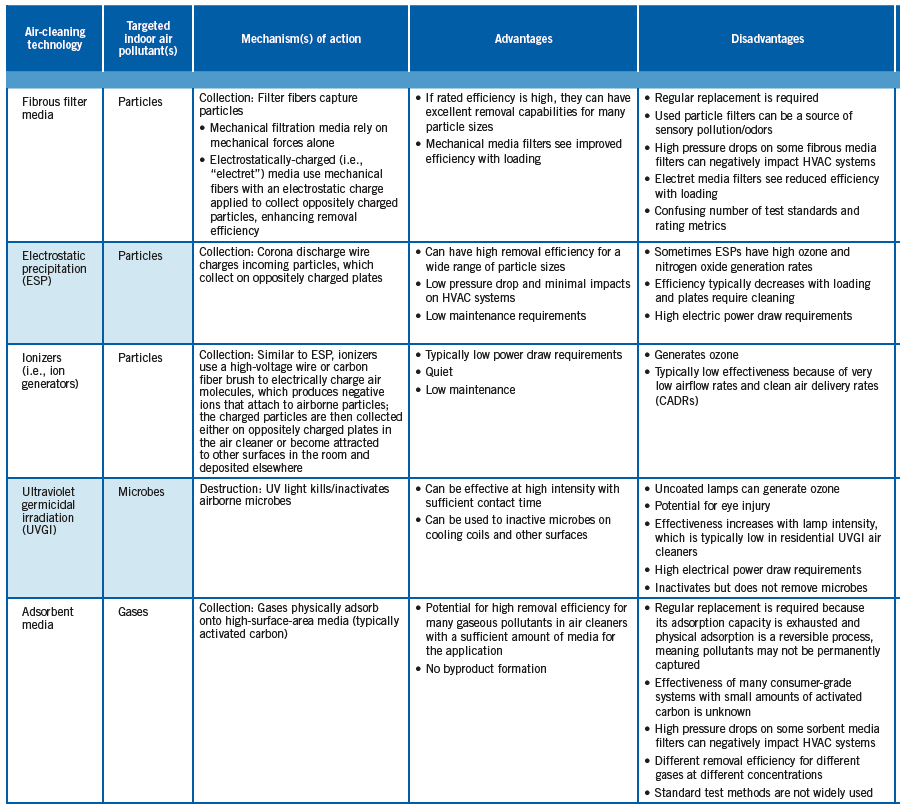
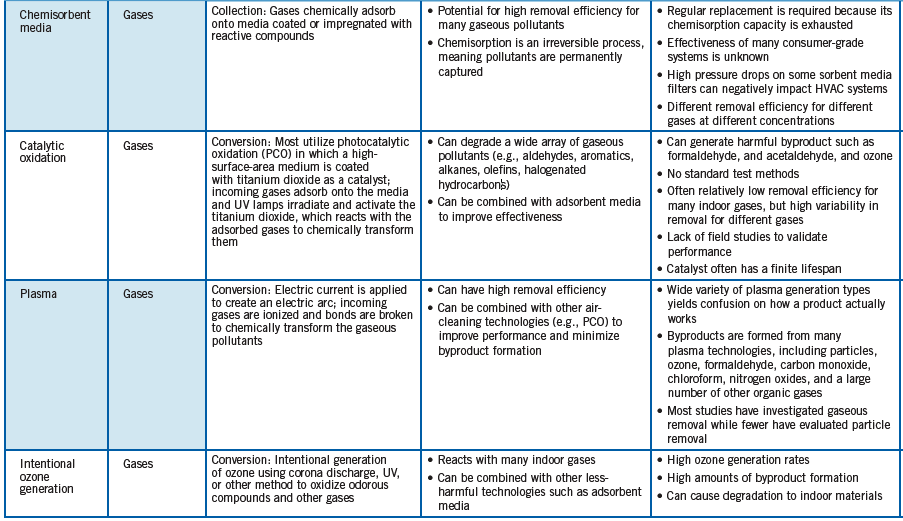
The document above is addressed to the residential market, but the technology is the same whether you put it in a home, school, or coffeeshop.
Two reasons to avoid most electronic air cleaners
When I spoke with Marwa Zaatari, she told me that the results being promised by companies selling most types of electronic air cleaners are overblown. Independent researchers haven’t been able to reproduce the high effectiveness rates claimed by the manufacturers. Here’s a Twitter thread she posted about the research into needlepoint bipolar ionization. She examined three claims: reduced particle counts, deactivation of the SARS-COV-2 virus, and the removal of formaldehyde and volatile organic compounds. She found that what manufacturers are claiming is either false or can’t be verified by independent researchers.
So, reason No. 1 is that a lot of electronic air cleaners just don’t do what they say they’ll do. There aren’t really any standards or regulations they have to follow. They can pretty much devise their own tests of effectiveness, keep the test methods to themselves, and claim whatever they want. Jim Rosenthal illustrated this problem brilliantly with a spoof article claiming 93% effectiveness in reducing viruses, mold, and bacteria with a simple incandescent lamp.
The second reason to avoid most electronic air cleaners is that they may actually be bad for indoor air quality. I’ve already established that ozone is bad for indoor air. Many electronic air cleaners release ozone as a by-product. Some release formaldehyde. Some may even put carbon monoxide into the indoor air. See the Disadvantages column in the table above.
Zaatari and Dr. Marcel Harmon wrote an article titled Open Letter to address the use of Electronic Air Cleaning Equipment in Buildings, in which they covered in great detail these two problems with electronic air cleaners. In addition, another 12 of the top researchers in indoor air quality reviewed and supported the letter. If you want specifics with references, read the letter and add it to your bookmarks.
What are the best ways to clean the indoor air?
I’ll restate what I wrote in my article on UVGI: Your best bet is still source control, filtration, and ventilation for good indoor air quality, and that’s where you should start. UVGI can be effective but is best for health care and other facilities where the systems will be engineered properly and overseen by the facilities staff.
Source control means not bringing pollutants into the building. It also means not generating them with devices like ionizers or photocatalytic oxidizers. And I shouldn’t have to say this, but if you still allow smoking in your home, you have a huge source control opportunity.
Filtration in homes is often done poorly but a good HVAC system can incorporate MERV-13 filters with low pressure drop. A portable MERV-13 or HEPA air cleaner is a good alternative if you can’t get good filtration with your HVAC system, and you can even make one yourself. Filtration with MERV-13 and higher or with HEPA filters will remove a lot of the particles in the indoor air.
For gases and other pollutants not captured by the filters, ventilation helps. Adding outdoor air can improve indoor air quality through dilution. Just make sure you filter the ventilation air, as most indoor PM2.5 comes from outdoor air. To see how much air exchange you’re getting, monitor the indoor carbon dioxide level.
The main conclusion here is that ultraviolet air cleaners and maybe electrostatic precipitators are the only electronic air cleaners worth considering. You should avoid all others because at best they may not be effective and at worst they could be making your indoor air worse. This past year of the pandemic has put a big spotlight on indoor air quality. With the IAQ workhorses of source control, filtration, and ventilation, we have a chance to make a huge difference in our indoor environments.
Zaatari, however, highlighted the risk of this spotlight: “Think of a world where after this pandemic we have worse indoor air quality.” That’s what could happen if we adopt electronic air cleaners over source control, filtration, and ventilation.
_________________________________________________________________________
Allison Bailes of Atlanta, Georgia, is a speaker, writer, building science consultant, and founder of Energy Vanguard. He is also the author of the Energy Vanguard Blog and is writing a book. You can follow him on Twitter at @EnergyVanguard.
Weekly Newsletter
Get building science and energy efficiency advice, plus special offers, in your inbox.





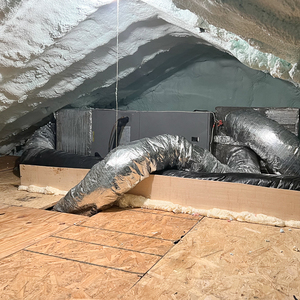
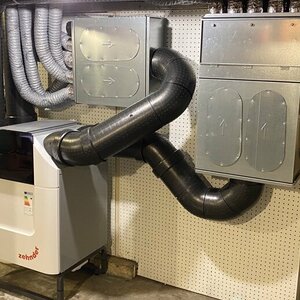

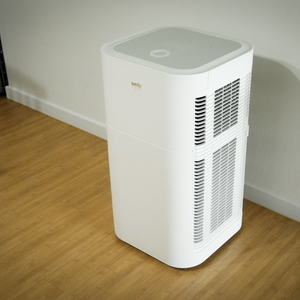






5 Comments
Question : Doesn't ozone work well for removing odors ?
IIRC ozone generators are used by hotels and some automotive shops to remove odors.
John - Ozone (in relatively high concentration) is very effective oxidizing a number of chemical compounds and biological items we consider pollution. Ozone (in high concentration) is also quite effective at damaging the human body. Proper application of ozone can remediate these type of problems, but (safely) only in spaces unoccupied by people. I believe Allison is directing his article towards air treatment systems/devices intended to serve occupied spaces.
Exactly. Ozone generators are used effectively by fire&smoke remediators and for remediation of other pretty nasty odors and some organic contamination. But the concentrations required are immediately dangerous to human health. Think pesticide. The people selling ozone generators for normal day-to-day use are charlatans. If there is enough ozone to have any remedial effect, there is also enough to cause health issues. Ozone is a pollutant at just about any concentration.
Peter,
The resort I did a lot of work for used them between guests. They were very effective, but the provincial Workers Compensation Board would not allow any of the housekeeping staff to enter the units for an hour after they had been turned off.
There is an excellent 3 part series of videos from Home Performance on Youtube about the harmful effects of electronic air cleaners.
https://www.youtube.com/watch?v=erKSLZeqM08 {part 1}
https://www.youtube.com/watch?v=HiPKubRvVqk {part 2}
https://www.youtube.com/watch?v=2wlnYCnb094 {part 3}
Part two goes into detail about how the air cleaners alter the chemicals in the house, thereby creating new chemicals {about minute 18:20}
Log in or create an account to post a comment.
Sign up Log in